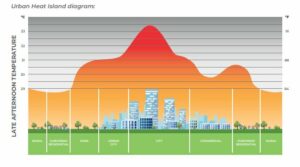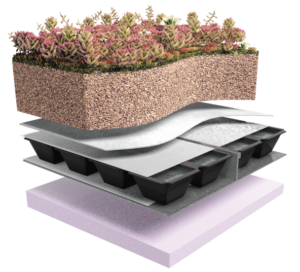As the UK and Europe experiences unprecedented spells of hot weather, with record high temperatures set to be reached this July, it is important to consider ways that future temperature rises and the reliance on the energy intensive air conditioning of buildings can be reduced. This is especially important when such heat wave events are forecast to occur more frequently with the advent of climate change and given the continued rise in energy costs. A key method to reduce this impact is to green as much roof space as possible, particularly in urban environments.
Urban Heat Island Effect
This is because city centres generate higher temperatures than the surrounding rural areas, a phenomenon known as the Urban Heat Island Effect. During the day radiation from the sun is absorbed by the hard concrete and bituminous surfaces within a city that heat up and create a hotter micro-climate. Urban temperatures are often many degrees higher than the surrounding countryside as a result, leading to an increased energy demand to cool city buildings.

Credit: Green Roof Code of Best Practice
Incorporating a Green Roof reflects a large part of this radiation back into space, which creates a cooler surface for the vegetated surfaces compared to traditional roof constructions. The many layers within a Green Roof system also prevent solar radiation from increasing roof surface temperatures with the evaporation of water from soil surfaces and the leaves of plants on a green roof helping to cool the surrounding air, further reducing air conditioning demand. Green Roofs are also compatible with solar PV installations, and since the planting helps to regulate and create a more constant surface temperature, the solar panels operate more efficiently throughout the day.

Extensive sedum Green Roof design
Maintenance requirements
Extended periods of dry and warm weather also highlight the importance of ongoing maintenance agreements and the choice of drought resistant planting such as sedums, where feasible. Alternatively, where planting is required to fit the local biodiversity profile (such as on the ABG designed Leeds Skelton Lake Services wildflower roof), a programmed irrigation system to maintain optimum moisture levels should be considered. Geogreen offer maintenance packages for all its Green Roof installations where the building is not being adopted by the local facilities team.

Leeds Skelton Lake Services Wildflower Roof
ABG and Geogreen have over 30 years’ of experience in the design and installation of Green Roofs, with continual R&D investment into achieving innovation and best practice in the sector. Please contact us for more info.